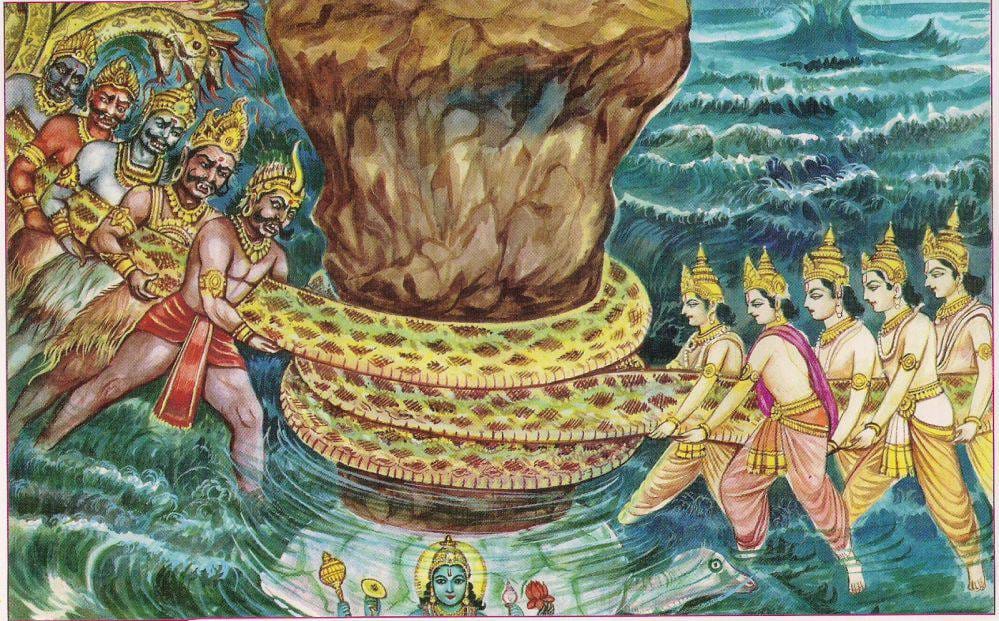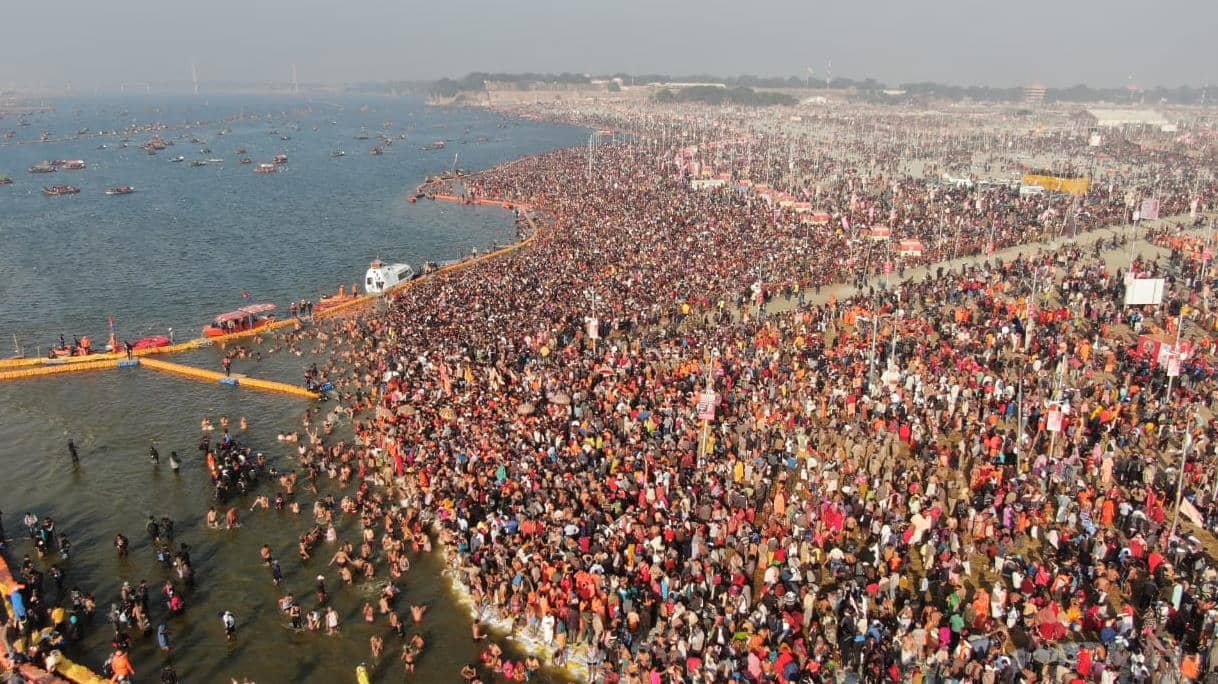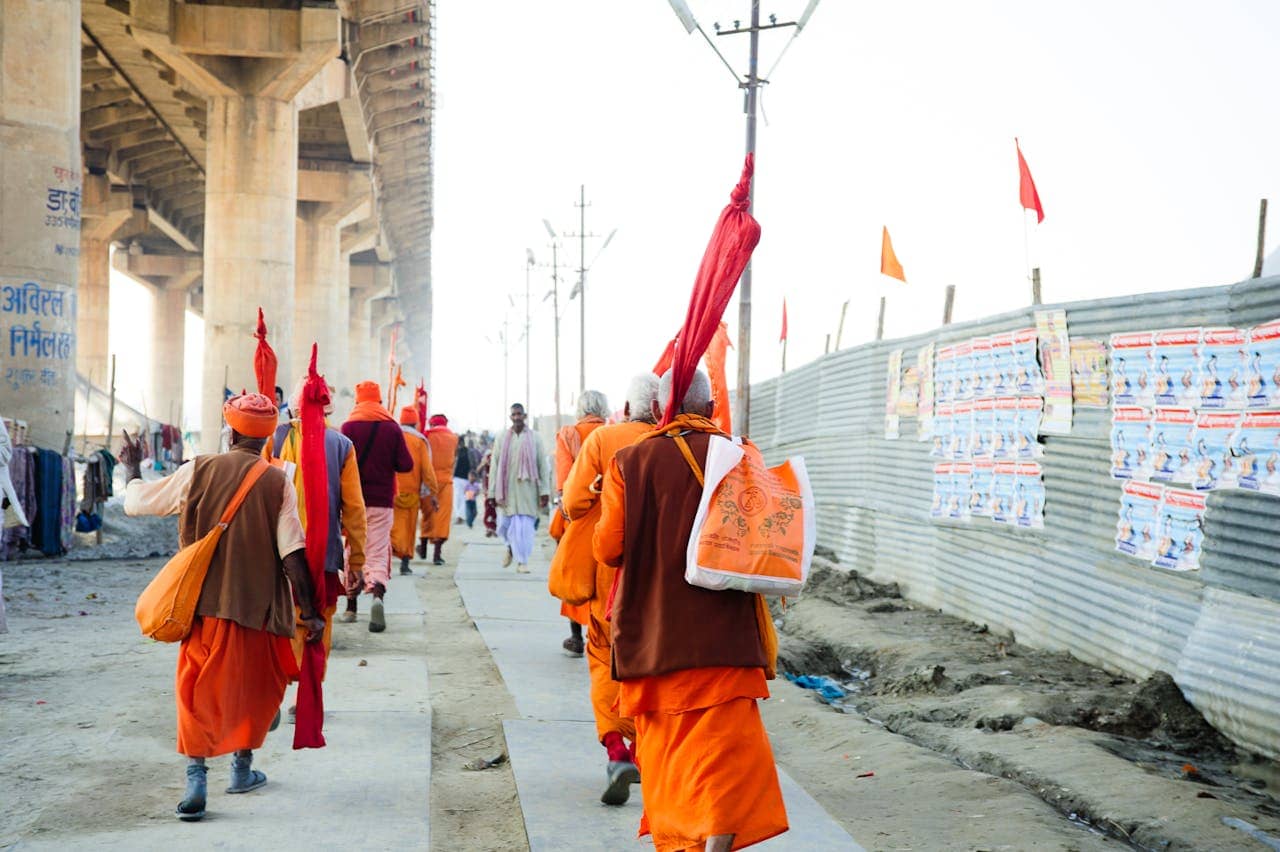At the heart of the extraordinary phenomenon of the Kumbh Mela lies an ancient and captivating legend that echoes with celestial battles, divine trickery, and the eternal human quest for immortality. It’s the story of the Samudra Manthan, the Churning of the Milk Ocean, and the drops of Amrit that forever linked four earthly locations to the realm of the divine.
Churning the Ocean of Immortality
In a time before time, as chronicled in the sacred scriptures of Hinduism, a great imbalance arose within the cosmos. The Devas (gods), weakened by a curse, found their celestial power waning. Meanwhile, the Asuras (demons), emboldened, sought to gain dominion over the universe. Recognizing the need to restore balance and regain their strength, the gods approached Lord Vishnu, the preserver of the universe, for guidance.
Lord Vishnu devised a cunning plan. He advised the Devas to propose a temporary truce and a joint endeavor to the Asuras – the Samudra Manthan, the churning of the primordial Milk Ocean. Vishnu explained that hidden within the depths of the vast ocean were treasures and potent elixirs, including the coveted Amrit, the nectar of immortality. Blinded by their own ambition, the Asuras agreed to this seemingly collaborative venture.
The Cosmic Battle
The stage was set for a cosmic drama. Mount Mandara, an immense peak, was uprooted to serve as the churning rod, and the mighty serpent-king, Vasuki, was to become the churning rope. The Devas and Asuras positioned themselves on opposite sides; the Devas holding Vasuki’s tail and the Asuras his head.
And so began a titanic struggle, one that shook the very foundations of the universe. With rhythmic pulls, the Devas and Asuras churned the ocean, its milky waters frothing and foaming as its depths were disturbed. As the churning intensified, various treasures emerged from the ocean — Kamadhenu, the wish-fulfilling cow, the divine horse Uchhaishravas, Airavata, the majestic white elephant, and the radiant Goddess Lakshmi, among others.
Then, a noxious poison known as Halahala arose, a substance so potent it threatened to annihilate all of creation. In a selfless act to safeguard the universe, Lord Shiva consumed the poison, but it scorched his throat, leaving it forever blue, earning him the epithet ‘Neelkanth’ (The Blue-Throated One).
Finally, Dhanvantari, the celestial physician, emerged from the ocean, carrying the Kumbh – a magnificent pot containing the precious Amrit.
Vishnu’s Intervention
As soon as the Amrit manifested, a fierce battle erupted between the Devas and Asuras, both desperate to claim the nectar for their own. Recognizing the potential for chaos, Lord Vishnu transformed into Mohini, an enchanting celestial maiden whose beauty was unmatched. Entranced by her appearance, the Asuras surrendered the Kumbh to her.
Mohini, cleverly deceiving the Asuras, distributed the Amrit solely among the Devas, restoring their celestial strength. However, an Asura named Rahu, disguised himself as a Deva and managed to consume a portion of the nectar. The Sun and Moon gods, Surya and Chandra, alerted Mohini to this deception. Enraged, Vishnu severed Rahu’s head from his body, but as the Amrit had already touched his throat, he achieved an immortal, albeit disembodied, existence in the celestial firmament as the head of Rahu and the tail of Ketu, forever known for causing eclipses by attempting to swallow the Sun and Moon.
Drops of Eternity
A chaotic chase ensued as the Devas, led by Jayant, son of Indra, sought to flee with the Amrit. The Asuras, realizing Mohini’s trickery, pursued them relentlessly for twelve days and twelve nights, a period equivalent to twelve human years. Throughout this celestial pursuit, it is believed that drops of the Amrit fell at four locations: Prayagraj (Allahabad), Haridwar, Ujjain, and Nashik. These sites, forever sanctified by the touch of the divine elixir, became the pilgrimage destinations for future Kumbh Melas.
The legend of the Kumbh Mela is a tale of celestial conflict, divine intervention, and the everlasting desire for transcendence. It’s the foundation upon which the spiritual significance and extraordinary legacy of the Kumbh Mela rests, drawing millions to the sacred river banks in a timeless quest for purification, liberation, and an encounter with the divine.


